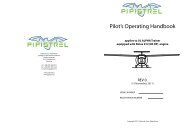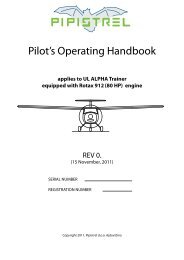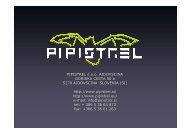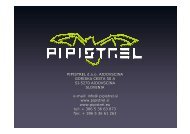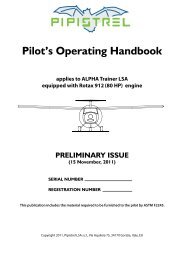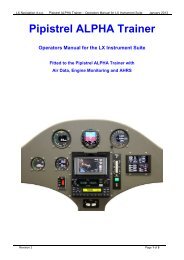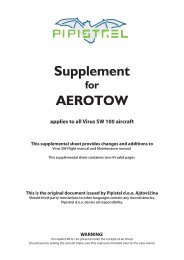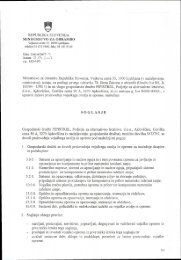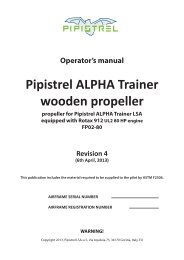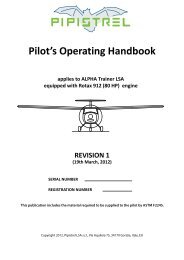Taurus ELECTRO manual 472 ENG.pdf - Pipistrel
Taurus ELECTRO manual 472 ENG.pdf - Pipistrel
Taurus ELECTRO manual 472 ENG.pdf - Pipistrel
Create successful ePaper yourself
Turn your PDF publications into a flip-book with our unique Google optimized e-Paper software.
www.pipistrel.si<br />
Roundout and touchdown<br />
TAURUS <strong>ELECTRO</strong> 41<br />
Normal procedures<br />
REV. 0<br />
CAUTION! See chapter “Performance” for landing performance.<br />
Final roundout (flare) and touchdown should be performed at following airspeeds:<br />
Calm air, aircraft at MTOM<br />
Rough air, aircraft at MTOM (incl. strong crosswinds up to 28 km/h (15 kts))<br />
75 km/h (40 kts) IAS<br />
78 km/h (42 kts) IAS<br />
CAUTION! Land the aircraft in such a manner that all three wheels touch the<br />
ground at exactly the same time. When touching down, rudder MUST NOT be deflected<br />
in any direction (rudder pedals centred).<br />
When on ground, start braking action holding the control stick in full back position. Stear the aircraft<br />
by using rudder inputs. Provided the runway length is sufficient, come to a complete standstill without<br />
engaging the brakes to ensure their long life.<br />
WARNING! After touchdown, DO NOT retract spoilers immediately, As this<br />
causes sudden lift increase and the aircraft may rebound off the ground.<br />
Should this occur, hold the elevator steady; under no circumstances attempt<br />
to follow aircraft’s movement with elevator deflections, SINCE <strong>Taurus</strong> Electro<br />
tends to attenuate rebounding by itself. However, it is important to maintain<br />
runway heading using the rudder at all times. TO PREVENT THIS, Retract spoilers<br />
only after the aircraft has come to a complete standstill.<br />
WARNING! Touch and go-es are not possible!<br />
Having reached a complete standstill, extend the motor (Motor start-up) and taxi (Taxi) off the runway.<br />
Crosswind approach and roundout<br />
CAUTION! Crosswinds prolong landing runway length (see chapter<br />
“Performance”).<br />
Performing a crosswind landing, the wing-low method should be used. When using the wing-low<br />
method it is necessary to gradually increase the deflection of the rudder and aileron to maintain the<br />
proper amount of drift correction.<br />
WARNING! If BY CHANCE the crab method of drift correction has been used<br />
throughout the final approach and roundout, the crab must be removed the<br />
instant before touchdown, by applying rudder to align the aircraft’s longitudinal<br />
axis with its direction of movement.





